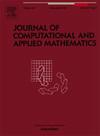Developing and analyzing a FDTD method for simulation of metasurfaces
IF 2.1
2区 数学
Q1 MATHEMATICS, APPLIED
Journal of Computational and Applied Mathematics
Pub Date : 2024-11-21
DOI:10.1016/j.cam.2024.116364
引用次数: 0
Abstract
Metasurfaces as 2-D metamaterials have a subwavelength thickness. Direct simulation is very challenging since very fine meshes are needed around the metasurfaces. Here we develop the generalized sheet transition conditions (GSTCs) based finite-difference time-domain (FDTD) scheme by treating the metasurface as a zero-thickness plane. The effectiveness of the scheme is illustrated by three representative examples. We raise the open issue on how to establish the numerical stability of such GSTC-based FDTD scheme.
开发和分析用于模拟超表面的 FDTD 方法
作为二维超材料的超表面具有亚波长厚度。由于超表面周围需要非常精细的网格,因此直接模拟非常具有挑战性。在这里,我们将超表面视为零厚度平面,开发了基于广义薄片过渡条件(GSTCs)的有限差分时域(FDTD)方案。我们通过三个具有代表性的例子说明了该方案的有效性。我们提出了如何建立这种基于 GSTC 的 FDTD 方案的数值稳定性这一未决问题。
本文章由计算机程序翻译,如有差异,请以英文原文为准。
求助全文
约1分钟内获得全文
求助全文
来源期刊
CiteScore
5.40
自引率
4.20%
发文量
437
审稿时长
3.0 months
期刊介绍:
The Journal of Computational and Applied Mathematics publishes original papers of high scientific value in all areas of computational and applied mathematics. The main interest of the Journal is in papers that describe and analyze new computational techniques for solving scientific or engineering problems. Also the improved analysis, including the effectiveness and applicability, of existing methods and algorithms is of importance. The computational efficiency (e.g. the convergence, stability, accuracy, ...) should be proved and illustrated by nontrivial numerical examples. Papers describing only variants of existing methods, without adding significant new computational properties are not of interest.
The audience consists of: applied mathematicians, numerical analysts, computational scientists and engineers.

 求助内容:
求助内容: 应助结果提醒方式:
应助结果提醒方式:


